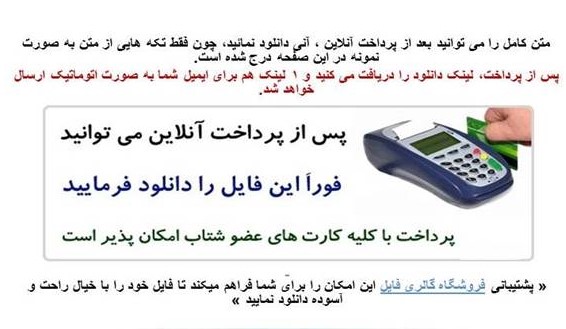دانلود با لینک مستقیم و پر سرعت .
لینک دانلود و خرید پایین توضیحات
فرمت فایل word و قابل ویرایش و پرینت
تعداد صفحات: 38
If not properly designed or rated, electrical equipment will often malfunction when harmonics are present in an electrical system.
Most people don't realize that harmonics have been around a long time. Since the first AC generator went online more than 100 years ago, electrical systems have experienced harmonics. The harmonics at that time were minor and had no detrimental effects.
Basic concept
A pure sinusoidal voltage is a conceptual quantity produced by an ideal AC generator built with finely distributed stator and field windings that operate in a uniform magnetic field. Since neither the winding distribution nor the magnetic field are uniform in a working AC machine, voltage waveform distortions are created, and the voltage-time relationship deviates from the pure sine function. The distortion at the point of generation is very small (about 1% to 2%), but nonetheless it exists. Because this is a deviation from a pure sine wave, the deviation is in the form of a periodic function, and by definition, the voltage distortion contains harmonics.
When a sinusoidal voltage is applied to a certain type of load, the current drawn by the load is proportional to the voltage and impedance and follows the envelope of the voltage waveform. These loads are referred to as linearloads (loads where the voltage and current follow one another without any distortion to their pure sine waves). Examples of linear loads are resistive heaters, incandescent lamps, and constant speed induction and synchronous motors.
In contrast, some loads cause the current to vary disproportionately with the voltage during each half cycle. These loads are classified as nonlinear loads, and the current and voltage have waveforms that are nonsinusoidal, containing distortions, whereby the 60-Hz waveform has numerous additional waveforms superimposed upon it, creating multiple frequencies within the normal 60-Hz sine wave. The multiple frequencies are harmonics of the fundamental frequency.
Normally, current distortions produce voltage distortions. However, when there is a stiff sinusoidal voltage source (when there is a low impedance path from the power source, which has sufficient capacity so that loads placed upon it will not effect the voltage), one need not be concerned about current distortions producing voltage distortions.
Examples of nonlinear loads are battery chargers, electronic ballasts, variable frequency drives, and switching mode power supplies. As nonlinear currents flow through a facility's electrical system and the distribution-transmission lines, additional voltage distortions are produced due to the impedance associated with the electrical network. Thus, as electrical power is generated, distributed, and utilized, voltage and current waveform distortions are produced.
Power systems designed to function at the fundamental frequency, which is 60-Hz in the United States, are prone to unsatisfactory operation and, at times, failure when subjected to voltages and currents that contain substantial harmonic frequency elements. Very often, the operation of electrical equipment may seem normal, but under a certain combination of conditions, the impact of harmonics is enhanced, with damaging results.
Motors
There is an increasing use of variable frequency drives (VFDs) that power electric motors. The voltages and currents emanating from a VFD that go to a motor are rich in harmonic frequency components. Voltage supplied to a motor sets up magnetic fields in the core, which create iron losses in the magnetic frame of the motor. Hysteresis and eddy current losses are part of iron losses that are produced in the core due to the alternating magnetic field. Hysteresis losses are proportional to frequency, and eddy current losses vary as the square of the frequency. Therefore, higher frequency voltage components produce additional losses in the core of AC motors, which in turn, increase the operating temperature of the core and the windings surrounding in the core. Application of non-sinusoidal voltages to motors results in harmonic current circulation in the windings of motors. The net rms current is [I.sub.rms] = [square root of [([I.sub.1]).sup.2] + [([I.sub.2]).sup.2] + [([I.sub.3]).sup.2] +] ..., where the subscripts 1, 2, 3, etc. represent the different harmonic currents. The [I.sub.2]R losses in the motor windings vary as the square of the rms current. Due to skin effect, actual losses would be slightly higher than calculated values. Stray motor losses, which include winding eddy current losses, high frequency rotor and stator surface losses, and tooth pulsation losses, also increase due to harmonic voltages and currents.
The phenomenon of torsional oscillation of the motor shaft due to harmonics is not clearly understood, and this condition is often disregarded by plant personnel. Torque in AC motors is produced by the interaction between the air gap magnetic field and the rotor-induced currents. When a motor is supplied non-sinusoidal voltages and currents, the air gap magnetic fields and the rotor currents contain harmonic frequency components.
The harmonics are grouped into positive (+), negative (-) and zero (0) sequence components. Positive sequence harmonics (harmonic numbers 1,4,7,10,13, etc.) produce magnetic fields and currents rotating in the same direction as the fundamental frequency harmonic. Negative sequence harmonics (harmonic numbers 2,5,8,11,14, etc.) develop magnetic fields and currents that rotate in a direction opposite to the positive frequency set. Zero sequence harmonics (harmonic numbers 3,9,15,21, etc.) do not develop usable torque, but produce additional losses in the machine. The interaction between the positive and negative sequence magnetic fields and currents produces torsional oscillations of the motor shaft. These oscillations result in shaft vibrations. If the frequency of oscillations coincides with the natural mechanical frequency of the shaft, the vibrations are amplified and severe damage to the motor shaft may occur. It is important that for large VFD motor installations, harmonic analyses be performed to determine the levels of harmonic distortions and assess their impact on the motor.
Transformers
The harmful effects of harmonic voltages and currents on transformer performance often go unnoticed until an actual failure occurs. In some instances, transformers that have operated satisfactorily for long periods have failed in a relatively short time when plant loads were changed or a facility's electrical system was reconfigured. Changes could include installation of variable frequency drives, electronic ballasts, power factor improvement capacitors, arc furnaces, and the addition or removal of large motors.
Application of nonsinusoidal excitation voltages to transformers increase the iron lesses in the magnetic core of the transformer in much the same way as in a motor. A more serious effect of harmonic loads served by transformers is due to an increase in winding eddy current losses. Eddy currents are circulating currents in the conductors induced by the sweeping action of the leakage magnetic field on the conductors. Eddy current concentrations are higher at the ends of the transformer windings due to the crowding effect of the leakage magnetic fields at the coil extremities. The eddy current losses increase as the square of the current in the conductor and the square of its frequency. The increase in transformer eddy current loss due to harmonics has a significant effect on the operating temperature of the transformer. Transformers that are required to supply power to nonlinear loads must be derated based on the percentages of harmonic components in the load current and the rated winding eddy current loss.
One method of determining the capability of transformers to handle harmonic loads is by k factor ratings. The k factor is equal to the sum of the square of the harmonic currents multiplied by the square of the frequencies.
k = [([I.sub.1]).sup.2]([1.sup.2]) + [([I.sub.2]).sup.2]([2.sup.2]) + [([I.sub.3]).sup.2]([3.sup.2]) + . . . + [([I.sub.n]).sup.2]([n.sup.2]).
where [I.sub.1] = ratio of fundamental current to total rms current, [I.sub.2] = ratio of second harmonic current to total rms current, [I.sub.3] = ratio of third harmonic current to total rms current, etc., and 1,2,3, ... n are harmonic frequency numbers. The total rms current is the square root of the sum of square of the individual currents.
By providing additional capacity (larger-size or multiple winding conductors), k factor rated transformers are capable of safely withstanding additional winding eddy current losses equal to k times the rated eddy current loss. Also, due to the additive nature of triplen harmonic (3, 9, 15, etc.) currents flowing in the neutral conductor, k rated transformers are provided with a neutral terminal that is sized at least twice as large as the phase terminals.



